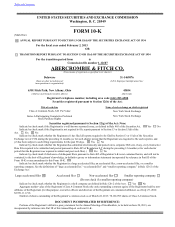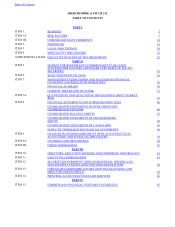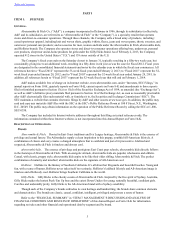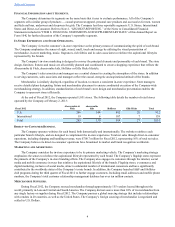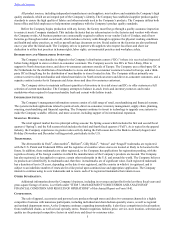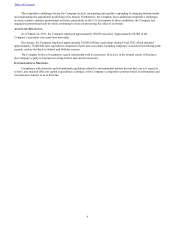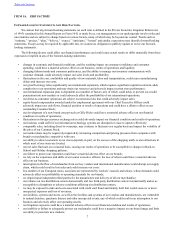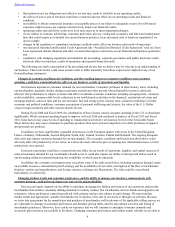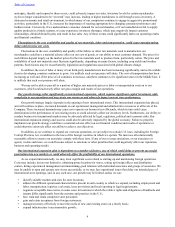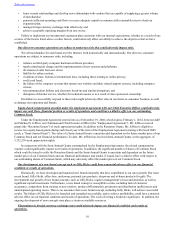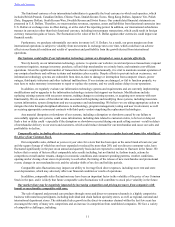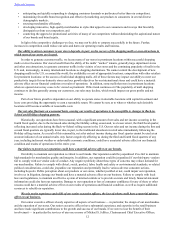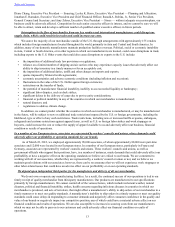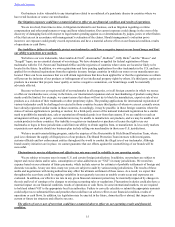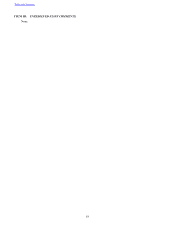Abercrombie & Fitch 2013 Annual Report Download - page 8
Download and view the complete annual report
Please find page 8 of the 2013 Abercrombie & Fitch annual report below. You can navigate through the pages in the report by either clicking on the pages listed below, or by using the keyword search tool below to find specific information within the annual report.
8
• fluctuations in our tax obligations and effective tax rate may result in volatility in our operating results;
• the effects of war or acts of terrorism could have a material adverse effect on our operating results and financial
condition;
• our inability to obtain commercial insurance at acceptable prices or our failure to adequately reserve for self-insured
exposures might increase our expenses and adversely impact our financial results;
• operating results and cash flows at the store level may cause us to incur impairment charges;
• we are subject to customs, advertising, consumer protection, privacy, zoning and occupancy and labor and employment
laws that could require us to modify our current business practices, incur increased costs or harm our reputation if we
do not comply;
• changes in the regulatory or compliance landscape could adversely affect our business and results of operations;
• our unsecured Amended and Restated Credit Agreement (the “Amended and Restated Credit Agreement”) and our Term
Loan Agreement include financial and other covenants that impose restrictions on our financial and business operations;
and
• compliance with changing regulations and standards for accounting, corporate governance and public disclosure could
adversely affect our business, results of operations and reported financial results.
The following sets forth a description of the preceding risk factors that we believe may be relevant to an understanding of
our business. These risk factors could cause actual results to differ materially from those expressed or implied in any of our
forward-looking statements.
Changes in economic and financial conditions, and the resulting impact on consumer confidence and consumer
spending, could have a material adverse effect on our business, results of operations and liquidity.
Our business depends on consumer demand for our merchandise. Consumer purchases of discretionary items, including
our merchandise, generally decline during recessionary periods and other periods where disposable income is adversely
affected. Our performance is subject to factors that affect worldwide economic conditions including unemployment, consumer
credit availability, consumer debt levels, reductions in net worth based on declines in the financial, residential real estate and
mortgage markets, sales tax rates and tax rate increases, fuel and energy prices, interest rates, consumer confidence in future
economic and political conditions, consumer perceptions of personal well-being and security, the value of the U.S. Dollar
versus foreign currencies and other macroeconomic factors.
During Fiscal 2008 and Fiscal 2009, the combination of these factors caused consumer spending in the U.S. to deteriorate
significantly. While consumer spending began to improve in Fiscal 2010 and continued to improve in Fiscal 2011 and Fiscal
2012, these factors may cause levels of spending to remain depressed relative to historical levels for the foreseeable future.
These factors also may cause consumers to purchase products from lower-priced competitors or to defer purchases of apparel
and personal care products.
In addition, we have significantly expanded our presence in the European market with stores in the United Kingdom,
France, Germany, Netherlands, Austria, Belgium, Spain, Italy, Ireland, Sweden, Poland and Denmark. The ongoing European
debt crisis may impact consumer demand for our merchandise. The economic conditions and factors described above could
adversely affect the productivity of our stores, as well as adversely affect the pace of opening new international stores, or their
productivity once opened.
Economic uncertainty could have a material adverse effect on our results of operations, liquidity, and capital resources if
reduced consumer demand for our merchandise should occur. It could also impact our ability to fund growth and/or result in
our becoming reliant on external financing, the availability of which may be uncertain.
In addition, the economic environment may exacerbate some of the risks noted below, including consumer demand, strain
on available resources, international growth strategy and the availability of real estate, interruption of the flow of merchandise
from key vendors and manufacturers, and foreign currency exchange rate fluctuations. The risks could be exacerbated
individually, or collectively.
Changing fashion trends and consumer preferences, and the ability to manage our inventory commensurate with
customer demand, could adversely impact our sales levels and profitability.
Our success largely depends on our ability to anticipate and gauge the fashion preferences of our customers and provide
merchandise that satisfies constantly shifting demands in a timely manner. Our merchandise and our brands must appeal to our
consumers, whose preferences cannot be predicted with certainty and are also subject to rapid change. We must translate
market trends into appropriate, saleable merchandise far in advance of its sale in our stores or through our websites. Because
we enter into agreements for the manufacture and purchase of merchandise well in advance of the applicable selling season, we
are vulnerable to changes in consumer preferences and demand, pricing shifts, and the sub-optimal selection and timing of
merchandise purchases. Moreover, there can be no assurance that we will continue to anticipate consumer demands and
accurately plan inventory successfully in the future. Changing consumer preferences and fashion trends, whether we are able to
Table of Contents

